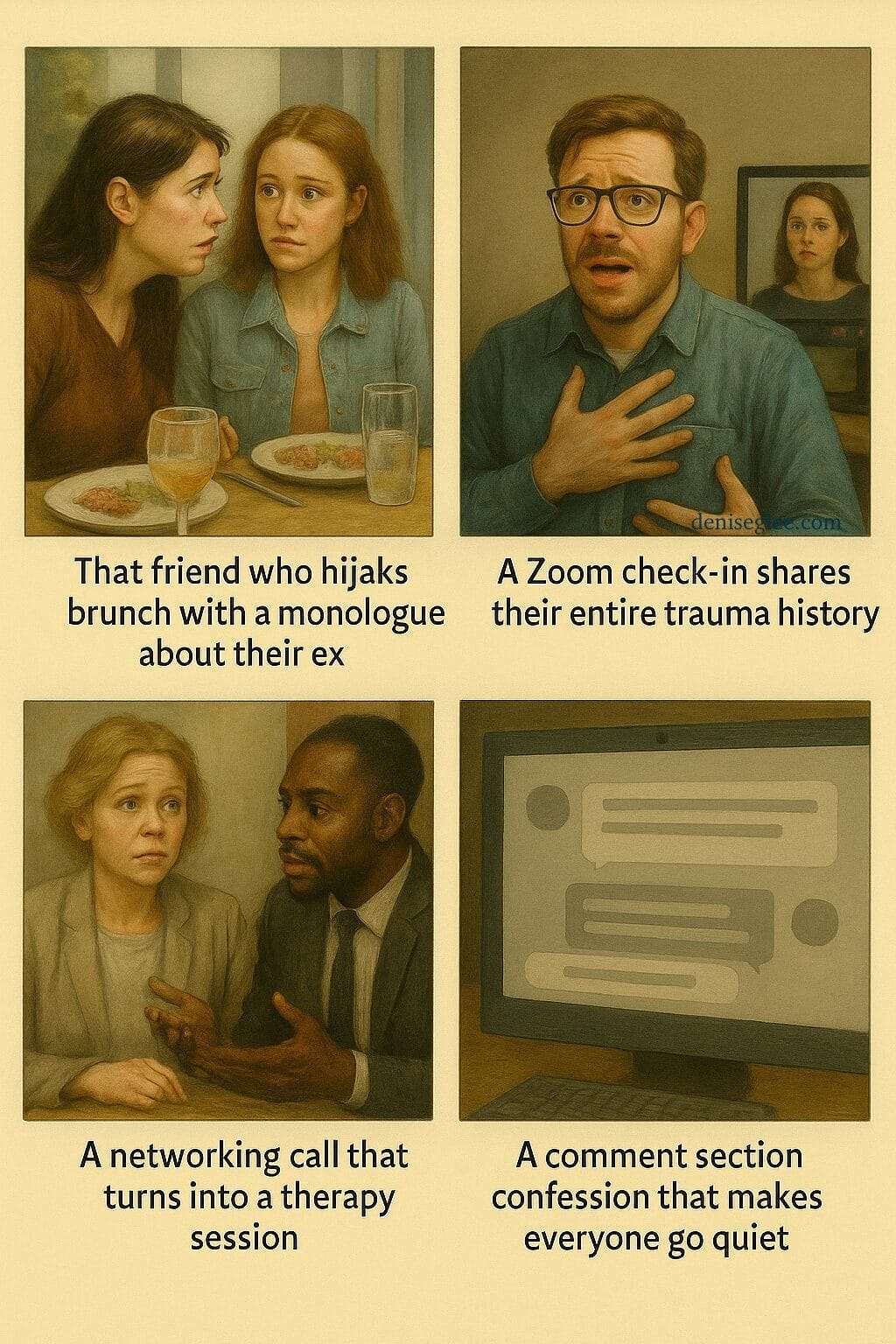
You Call It Sharing. But It Might Be Trauma Dumping.
- Updated: July 28, 2025
Folks are out here trauma dumping like they just chased raw meat with a melted ice cream shooter.
Sounds nasty? That’s because it is.
In healing spaces, everyone loves talking about trauma. But hardly anyone talks about its messier cousin: the unsolicited emotional purge that leaves people blinking in discomfort.
As a healing and leadership coach, I’ve had prospects, clients—even folks at the checkout line at the grocery store—unload their entire emotional archive on me when all I asked was, “How are you doing today?”

In this post, we’re going to talk about the kind of oversharing that should probably stay locked in a Reddit thread. You’ll learn what trauma dumping actually is, the sneaky psychology behind it, how it shows up in your life (and business), and what to do—whether you’re the one doing the dumping or the one getting emotionally splattered.
You might laugh, cringe, or side-eye your past self. That’s okay.
I got your back.
Here’s What We’ll Unpack
No, That’s Not Sharing—It’s Trauma Dumping
When I first started recovery from sex—and later alcohol—addiction, it was a relief to finally drop the mask and just be… me.
I found myself in rooms where people were sharing the good, the bad, and a whole lotta messy. So, with my semi-emotionally regulated self, I thought it was a great idea to take that same energy and share with anyone who had a pulse.
I told strangers about the nights I woke up in places I didn’t belong. I casually mentioned the time a suitor tried to molest me at a nightclub. Oh—and a bunch of other stories that, in hindsight, pushed the line from personal growth to soft-core chaos.
How did people respond?
Awkward stares.
Silence.
Avoidance.
Even full-on ghosting.
I felt hurt. Offended. Misunderstood.
Now I know the truth:
They weren’t rejecting me—they were reacting to trauma dumping.

When unprocessed pain becomes someone else’s burden
Here’s the thing:
Healthy sharing is mutual. It’s paced. It’s grounded in consent. It honors the relationship and the moment.
What I was doing wasn’t that.
It was trauma dumping.
Trauma dumping is when you flood someone with deeply personal, unprocessed pain—without warning.
It’s the emotional equivalent of screaming in someone’s ear in the middle of a quiet library.
Disorienting. Uncomfortable. Off-putting.
It feels urgent to the dumper.
But it’s overwhelming for the person on the receiving end.
Let’s be clear:
It’s not vulnerability.
It’s emotional hijacking.
Why Trauma Dumping Breaks Leadership Trust
If you’re leading a team, running a business, or holding space for others in any way, trauma dumping can quietly—and completely—wreck your credibility.

We’ve been conditioned to believe emotional transparency equals connection. And to be clear, vulnerability can be powerful—but only when it’s grounded, mutual, and invited.
Unfortunately, we live in a culture where oversharing is confused with leadership. We laugh at The Office, where Michael Scott blurts out way too much in the middle of meetings—and where every character emotionally bleeds into the Scranton breakroom. But in the real world? That kind of behavior creates anxiety, not belonging.
According to a 2023 survey by the American Psychological Association, 64% of employees say unclear communication from leadership is a top source of workplace stress. And trauma dumping? That’s not just unclear—it’s emotionally chaotic.
Let me say this with love:
Trauma dumping is not intimacy.
It’s not “being real.” Nor is it “building connection.”
It’s offloading your unprocessed pain onto people who didn’t agree to carry it.
And when that happens, trust erodes.
Because nobody feels safe when someone in power shares things that should be handled with care, consent, and context.
Instead of fostering psychological safety, you’ve just triggered the limbic system of the room. That’s not leadership. That’s leakage.
You might be wondering:
“Why would I do this?”
Totally fair question. In the next section, we’ll unpack why trauma dumping feels good in the moment, and why your brain might be tricking you into thinking it’s helping.
Why Oversharing Feels Good—But Isn’t Connection
Here’s the wild part:
Most people don’t mean to trauma dump.
They genuinely think they’re being open, relatable, “real.”
But under the surface? Something else is running the show.
And that “something” is often your anxious child ego—the part of you that never felt seen, heard, or safe growing up.
🧠 Trauma dumping can feel like relief… to you.
When you’re stuck in survival mode, dumping your pain feels like exhaling after holding your breath for too long. Your nervous system loves it. It gets that dopamine hit of release. Your inner child goes: “Finally! I’m not holding this alone.”
But here’s the catch:
That relief you feel? It’s not connection.
It’s a chemical reaction.
Your body is offloading pain the same way it might offload anxiety through nail biting or social media doom scrolling.
Except now it’s happening in public. With real stakes.
And often at the expense of your reputation, relationships, or leadership presence.
Let’s zoom in: What part of you is actually doing the talking?
When The Inner Child Takes Over
According to Transactional Analysis (a form of psychotherapy), we all operate from one of three ego states in any given moment:
Parent – The inner rulebook. Can sound nurturing or critical.
Adult – Grounded, present, logical. Assesses reality as it is.
Child – Emotional. Reactive. Often echoes past unmet needs.

When you trauma dump, you’re not in your Adult state.
You’re being run by your Child ego—specifically the anxious, attachment-hungry part that’s still trying to earn love by oversharing pain.
That part believes:
“If I unload everything, they’ll finally see me.”
“If I shock them with my story, they’ll finally stay.”
“If I’m real enough, maybe I’ll be loved.”
But that’s not connection.
That’s a performance of pain, rooted in fear.
👶 The anxious ego says: “If I unload, I’ll be loved.”
🧠 Your Adult self knows: “If I respect boundaries, I’ll be trusted.”
Big difference.
Instead of connection, trauma dumping creates confusion.
Instead of intimacy, it creates unease.
And instead of healing? You end up leaking—in places where containment is what actually builds trust.
This isn’t about shame.
It’s about understanding your life scripting and recognizing when your inner child is trying to lead the meeting.
And learning how to pause, recalibrate, and choose to respond from your Adult self instead.
Real-Life Examples of Trauma Dumping
Now that we’ve unpacked why trauma dumping happens—especially when our anxious child ego is running the show—let’s get into what it actually looks like in real life.

Yes, I shared my own facepalm-worthy moment earlier, but let’s be honest: this happens everywhere. Sometimes you’re the dumper, sometimes you’re the dumpee, and sometimes… you’re just sitting there, wondering what the heck just happened.
No shame—just awareness.
Here are some real-world trauma dumping moments you might recognize:
That friend who hijacks brunch with a monologue about their ex—again
That coworker who shares their entire trauma history in a Zoom check-in
That networking call that turns into a therapy session you didn’t ask for
That comment section confession that makes everyone go quiet
If you’re wondering if it’s too much—it probably is.

How to Know If You’re Trauma Dumping (or Absorbing It)
Let’s stop sugarcoating it. Trauma dumping isn’t always obvious—especially when it’s wrapped in good intentions, spiritual buzzwords, or “just being honest” energy.
Sometimes you’re the one doing it.
Sometimes you’re on the receiving end, slowly shrinking inside.
And sometimes you don’t even realize you’ve normalized it through enmeshment or misplaced loyalty.
Here are some undeniable signs you’re stuck in the cycle:

😵💫 You feel emotionally hungover after talking to someone.
Not just tired. Depleted. Like your soul got wrung out.
You’re reliving their pain hours later—and you didn’t even sign up for it.
🧍♂️ You’ve become the emotional sponge in your group.
Everyone vents to you.
You didn’t ask for it. They never ask how you are.
You’re the unpaid therapist with a polite smile and a cortisol spike.
📉 People start ghosting you, dodging your calls, or “rescheduling” a lot.
You think they’re flaky.
But deep down, part of you knows… maybe you’re a lot.
🗣️ You lead with pain—often.
You find yourself opening convos with:
“I’ve never told anyone this before, but…”
Or:
“Can I just vent for a sec?”
Only it’s never just a sec. And you feel lighter after.
But the other person? They look like they just got hit by a truck.
👂 You feel relief when someone else emotionally unloads on you—because you think it means trust.
Hint: It doesn’t always mean trust.
Sometimes it just means you’re an easy target.
A safe emotional dumping ground.
And your body knows it, even if your brain doesn’t.
🔁 You replay your overshares later and think, “Why did I say all that?”
That’s not shame. It is your Adult self waking up.
That’s your nervous system going, “We over-exposed again.”
Whew. I know. This is a lot.
That’s why in the next section, we’re not just naming the problem—we’re going to talk about how to handle it, whether you’re the one dumping or the one getting dumped on.
Because knowing is good.
But learning to do better? That’s where the power lives.
What to Do—Whether You’re Dumping or Absorbing
We’ve covered some wildly uncomfortable territory—so mad props for sticking with me this far. Whether you’ve been the one emotionally blindsided or the one doing the emotional bulldozing, this stuff can stir up old memories and current cringe.
So let’s talk solutions. Let’s talk repair.
Because no matter which side you’ve found yourself on—you can do better, starting now.

If You’re the Dumper:
1. Pause before you speak.
Ask yourself: “Is this the right time, place, and person?”
Just because the emotion is real doesn’t mean it belongs here.
2. Don’t confuse vulnerability with unfiltered venting.
Sharing pain isn’t bad—but dumping it without context, consent, or containment? That’s just emotional outsourcing.
3. Process before you project.
Write it out. Pray on it. Talk to your therapist, not your hairdresser.
Your healing is valid—but it’s not everyone’s job to witness the raw draft.
If You’re the Receiver:
1. Set clear, kind boundaries.
You can say: “I care about you—but I don’t have the emotional space for this right now.”
It’s not rude. It’s regulated.
2. Know what’s yours and what’s not.
You’re allowed to feel empathy without becoming the emotional landfill.
Don’t absorb their urgency as your responsibility.
3. Redirect without guilt.
Try: “That sounds heavy—have you had a chance to talk to someone professionally about it?”
You’re not rejecting them. You’re protecting both of you.
This work isn’t about being perfect.
It’s about being aware—and then choosing differently.
I hope these tips gave you something to hold onto.
The visual nearby sums it up, but the real takeaway?
Emotional maturity isn’t about never messing up—it’s about owning it when you do.
Up next, I’ll share some final thoughts to wrap it all together.
Where Healing Actually Begins
Sharing your story is powerful. But trauma dumping? That’s not healing—it’s leakage.
It drains the room, erodes trust, and teaches people to fear your presence instead of lean in.
We all carry pain. But the way we hold it—that’s what separates emotional maturity from survival-mode chaos.
If you want to lead, love, or live well, you have to know the difference between release and responsibility.
Between blurting and belonging.
Between trauma dumping—and trust-building.
Let’s stop hurling. Let’s start healing.
Ready to lead without dumping your emotional inbox on strangers?
💛 Work with me, Denise G. Lee – Together, we’ll unpack your emotional overload and build practical tools for growth and connection.
👉 Explore coaching with me
🎧 Want more grounded insight like this?
Check out my podcast where we talk about real healing in business and life.
👉 Listen to The Introverted Entrepreneur
📪 Got thoughts on this topic?
I’d love to hear from you—just keep it emotionally sober.
👉 Write me a note
And just in case you forgot:
Boundaries aren’t cold. They’re kind.
And trauma isn’t your whole story. It’s just one chapter.





